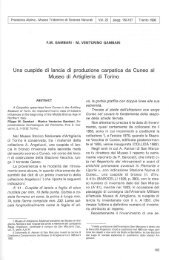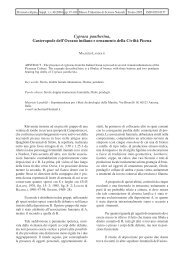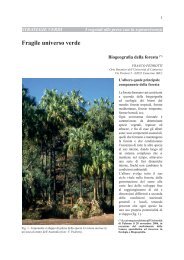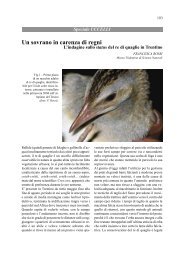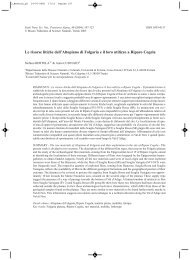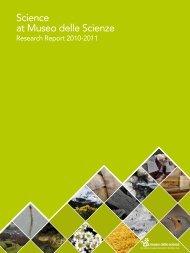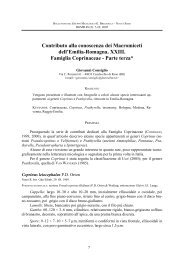scarica pdf 859KB - Museo Tridentino di Scienze Naturali
scarica pdf 859KB - Museo Tridentino di Scienze Naturali
scarica pdf 859KB - Museo Tridentino di Scienze Naturali
You also want an ePaper? Increase the reach of your titles
YUMPU automatically turns print PDFs into web optimized ePapers that Google loves.
328 Petti et al. Theropod and sauropod footprints from Central Apennines<br />
tyl tracks from Lama Paterno (late Bedoulian-early Gargasian;<br />
Apulia, Southern Italy, Sacchi et al. 2006) recently <strong>di</strong>scovered<br />
in carbonate platform deposits referred to the Apulian<br />
carbonate Platform (AP). Foot length and width are similar<br />
(FL = 15-20 cm, FW = 13 cm) for tracks in both regions.<br />
In general <strong>di</strong>git impressions are wider in the Apulian tracks<br />
with not well-defined claw marks and <strong>di</strong>git IV less impressed<br />
and pulled slightly back with respect to the base of the<br />
other <strong>di</strong>gits. Digit III in the Lama Paterno tracks is characterized<br />
by a longer protrusion.<br />
Tracks from Esperia <strong>di</strong>ffer from tridactyl footprints<br />
found on three <strong>di</strong>fferent levels from the Sezze tracksite (early<br />
Cenomanian; Lazio, Central Italy; Nicosia et al. 2007),<br />
also belonging to the Apenninic Platform domain. Tridactyl<br />
tracks from the II level are slightly larger, foot length varying<br />
from a minimum of 15 to a maximum of 24 cm, asymmetric<br />
and retain <strong>di</strong>git IV impression pulled back with respect<br />
to <strong>di</strong>gits II and III. On the other hand the protrusion of <strong>di</strong>git<br />
III is similar to one observed in the Esperia ichnites. Tracks<br />
from the highest bed<strong>di</strong>ng plane (III level), preserve printing<br />
of both <strong>di</strong>gitigrade and plantigrade gaits; tracks are tridactyl<br />
and in some cases show the entire metatarsal impression<br />
and the trace of <strong>di</strong>git I. In the III level, <strong>di</strong>git III extends the<br />
line linking the tips of <strong>di</strong>gits II and IV by a greater amount<br />
in comparison with the Esperia tridactyl footprints.<br />
A good match has been found with tridactyl tracks<br />
from Borgo Celano (late Hauterivian-early Barremian, Gargano<br />
Promontory, Apulia, Southern Italy; Petti et al. 2008)<br />
from the Apulian carbonate Platform deposits. Even if these<br />
latter tracks are sometimes posteriorly elongated, retaining<br />
the partial or the entire impression of the metatarsal,<br />
they show some similarities with the present specimens from<br />
which <strong>di</strong>ffer mainly in absolute <strong>di</strong>mensions, the Borgo Celano<br />
footprints being larger (FL varies from a minimum of<br />
23 cm to a maximum of 35 cm and up to 56 cm in the elongated<br />
tracks; FW from 23 cm to 36 cm). However, the protrusion<br />
<strong>di</strong>git III values (less than half the foot length), and<br />
the position of <strong>di</strong>git IV points to a close resemblance with<br />
ES 1, ES 2 and ES 3.<br />
4.1.2. Attribution to track maker<br />
Based on the features described above, the tridactyl footprints<br />
from Esperia could be attributed to a bipedal <strong>di</strong>nosaur,<br />
<strong>di</strong>gitigrade, probably a small-sized theropod. The height<br />
at the hip of these <strong>di</strong>nosaurs is 82.5 cm (h = 3.06 x (FL) 1.14 ;<br />
Thulborn 1990) while body length is 3.30 m (L = 4h; Paul<br />
1988). Body-mass could be estimated at about 60 kg (Thulborn<br />
1990).<br />
4.2. Non tridactyl footprints<br />
The second morphotype consists of round and elliptical<br />
footprints. The non-tridactyl material is even less well-preserved<br />
than the theropod footprints and no <strong>di</strong>agnostic features,<br />
useful to refer the specimens to existing ichnotaxa, have<br />
Fig. 5 - Close-up of sauropod footprints, showing probable manuspes<br />
couples. Hammer (33 cm) for scale.<br />
Fig. 5 - Particolare delle orme non-tridattile, dove risultano evidenti<br />
probabili coppie manus-pes. Il martello (33 cm) è utilizzato<br />
come scala.<br />
been observed. Nevertheless, and despite the trackways not<br />
being recognised, some features have allowed attribution of<br />
the morphotypes to possible zoological taxa. It is worth noting<br />
the occurrence of two or three probable manus-pes couples<br />
located in the right (southern) part of the trampled surface<br />
(Figs 3-5) recognized by their constant relative positions<br />
(the manus print in front or just lateral to the pes print). They<br />
probably are manus-pes sets made by a quadrupedal <strong>di</strong>nosaur,<br />
with sub-elliptical pes imprints, posteriorly-anteriorly elongated,<br />
and a manus trace sub-circular in shape. The pes imprints<br />
are larger than the manus ones (heteropody index about<br />
1/3). The sub-elliptical pes prints are longer (25-29 cm) than<br />
wide (16-20 cm). The manus impressions are as long as wide<br />
(8-13 cm). Larger footprints (FL around 40 cm) with irregular<br />
shape have also been noticed on the Esperia bed<strong>di</strong>ng<br />
plane, probably caused by the coalescence of two or more<br />
tracks, whose relationships are <strong>di</strong>fficult to <strong>di</strong>scern.<br />
4.2.1. Attribution to track maker<br />
The non-tridactyl footprints are probably the expression<br />
of pes and manus impression of a <strong>di</strong>nosaur with quadrupedal<br />
gait. Pes morphology varies from sub-elliptical to



